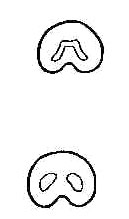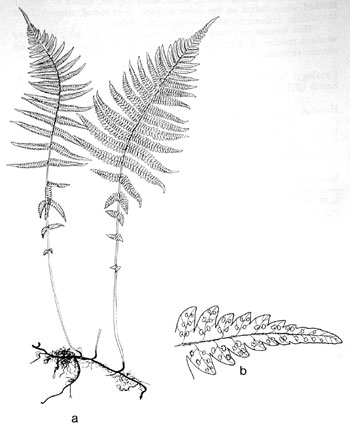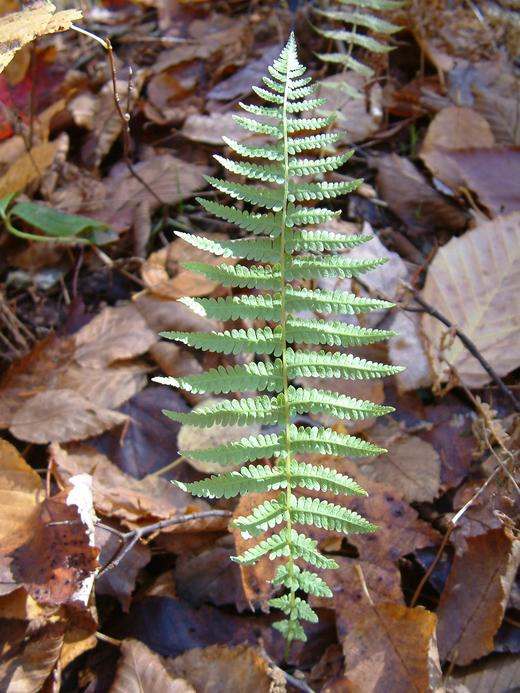|
Hardy Fern Home T. noveboracensis resources All Ferns � Thelypteridaceae �� Thelypteris
�Other Genera
|
| Thelypteris noveboracensis | ||
New York fern, Tapering fern | ||
|
Etymology
Noveboracense is the Latin for New York
Description
Rhizome: long-creeping, triangular scales.
Frond: 75 cm high by 15 cm wide, deciduous, monomorphic, blade/stipe ratio: 2:1 or more. Stipe: straw-colored, shading to green, scales tan to reddish brown, ovate, vascular bundles: 2, oblong, at 90�, at stipe base, merging above to a u-shape. Blade: 1-pinnate-pinnatifid, cuts falling short of meeting the costa by 1 mm, elliptic, tapering to both ends, the lowest pinnae less than 1 cm long, membranous, yellow-green, transparent needlelike hairs, sparsely glandular, the margins also hairy. Pinnae: 20 to 24 pair, lanceolate, long tapering, less incised near the ends; pinnules oblong, about 1 cm; costae grooved above, discontinuous with the rachis; margins entire or crenate; veins free, forked or not. Sori: round, small, nearer the margin than the costule, absent from the ends of the pinnules (or the pinnae), indusium: reniform, tan, withering, at a sinus, maturity: early to mid-summer. Culture
Habitat: moist woods, especially near swamps, streams, and in vernal seeps of ravines, often in slightly disturbed secondary forests, frequently forming large colonies .
Distribution: eastern North America.
Hardy to -30�C, USDA Zone 4.
Distinctive Characteristics
Having the same aggressiveness, habitat and coloration as Dennstaedtia punctilobula, but differing dramatically in the tapering down of the lower blade here vs. widest near the bottom for the Dennstaedtia. The latter is also more divided.
Synonyms
Polypodium noveboracense Linnaeus Dryopteris noveboracensis (Linnaeus) A. Gray Parathelypteris noveboracensis (Linnaeus) Ching Thelypteris thelypterioides (Michaux) Holub |
|
|
Notes
Compare to Oreopteris limbosperma which has small lower pinnae, but is erect, forming a centered group of fronds, and lacks reniform indusia.
Compare to None of the other members of the genus have the tiny lower pinnae.
Compare to Oreopteris limbosperma which has small lower pinnae, but is erect, forming a centered group of fronds, and lacks reniform indusia.
Compare to None of the other members of the genus have the tiny lower pinnae.

Thelypteris noveboracensis. Two oval to elongate vascular bundles at the base of the stipe uniting above to an inverted v-shape above. �Drawing from Ferns of Northeastern United States, Farida A. Wiley, 1936. |

Thelypteris noveboracensis. a) fronds, much reduced lower pinnae; b) fertile pinna, veins meeting the margins above the base of the pinnules. �Illustration by V. Fulford from Ferns and Fern Allies of Canada, William J. Cody and Donald M. Britton, 1989, � Agriculture Canada, used with permission. |
